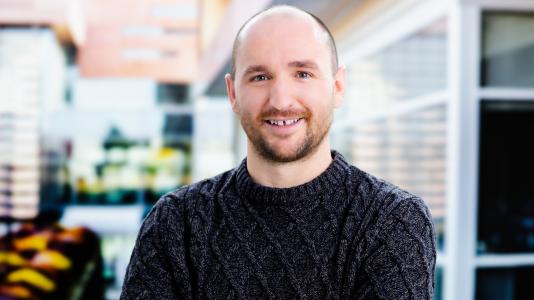The British scientist joined Argonne in 2020
By Jenna V. Wray | May 5, 2025

Physicist Sam Clark was nearly the only one on the plane in October 2020 when he traveled to the United States from his home in the English countryside. It was, after all, the first year of the COVID-19 pandemic, and traveling, especially internationally, was risky.
“But I was determined to come as soon as possible,” said Clark. “I was not about to miss this opportunity.”
The opportunity that excited him was a job as an assistant physicist at the U.S. Department of Energy’s (DOE) Argonne National Laboratory. Specifically, Clark would be joining Advanced Photon Source (APS), a DOE Office of Science user facility at Argonne known for its ability to perform some of the fastest imaging in the world.
Clark was no stranger to synchrotron science. For many years, as a postdoc at University College London (UCL), he collaborated with staff at Diamond Light Source, a similar facility in the U.K.
“I’m always inspired by the new ideas coming from our user community. I love when research proposals push the boundaries of what’s possible. It motivates me to keep innovating.” — Sam Clark, physicist at the APS
“Diamond is very powerful, but Argonne’s APS is the place researchers go when they need to do experiments with the highest temporal resolutions,” Clark said.
In fact, he’d traveled to Illinois in 2018 to do research at the APS, which was eventually published in Nature Communications. When he was hired two years later to return to the APS permanently, he was thrilled.
Clark’s specialty is high-speed X-ray imaging. “It’s like a medical X-ray, but extremely fast,” he explained. APS X-ray beams can capture tens of thousands of frames per second to millions of frames per second.
This astonishing speed allows researchers to understand processes that happen too quickly to study otherwise. For example, the APS can reveal precisely when defects form in a material during a manufacturing process. Scientists can use this data to prevent defects and create more reliable products.
As a beamline scientist, Clark helps visiting researchers realize their experiments. He’ll work with a research team, often for months, ensuring they will be able to trigger the event they want to study and get the images they need. These triggers need to happen accurately because at the beamline, imaging might only capture a few milliseconds of time.
When a research team arrives at Argonne, Clark and his colleagues train them on how to use the beamline safely and reliably. After they leave, he helps them analyze their data.
“I’m always inspired by the new ideas coming from our user community,” Clark said. “I love when research proposals push the boundaries of what’s possible. It motivates me to keep innovating.”
One study that’s particularly vivid in his memory investigated friction stir welding. This process is used to join two metal plates together. It’s particularly vital to the aerospace industry.
Clark recalled, “We needed to get a machine that weighed many tons into the experimental station. If we managed that, we needed to get our detector close enough to actually capture what’s going on. We were about fifty-fifty whether we could do this.”
To everyone’s relief, the study was a success. The images they captured were incredible. “The solid metal flowed like liquid,” said Clark. “It was amazing!”
Clark’s own research is aimed at developing X-ray techniques. He wants to help the APS capture even higher-resolution images at even faster rates. Currently, he’s helping build improved instrumentation to take full-advantage of the upgraded APS X-ray beams at the 32-ID beamline.
In his day-to-day work, Clark draws from a wide range of experience. His bachelor’s degree is in mechanical engineering; his master’s, in sustainable energy. He earned a Ph.D. in materials science, then his post-doctoral research focused on synchrotron work. Each of these fields gave Clark useful skills and perspectives that he uses today.
That said, Clark believes the most important quality of a beamline scientist goes beyond bullet points on a resume.
“Passion,” he said. “That’s what will keep you coming in at one or two in the morning when an experiment isn’t working. The key is to really love what you do and know that you’re making a difference.”
Sitting on that nearly empty plane just over four years ago, Clark believed his passion would find a home at Argonne’s APS. Looking back, he can only be proud of how right he was.
Fittingly, his experience with his former colleagues at UCL has come full circle. In 2023, his former team returned to Argonne to do another study, and Clark was happy to help them — this time, as an APS insider.
